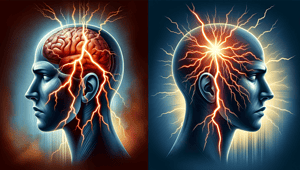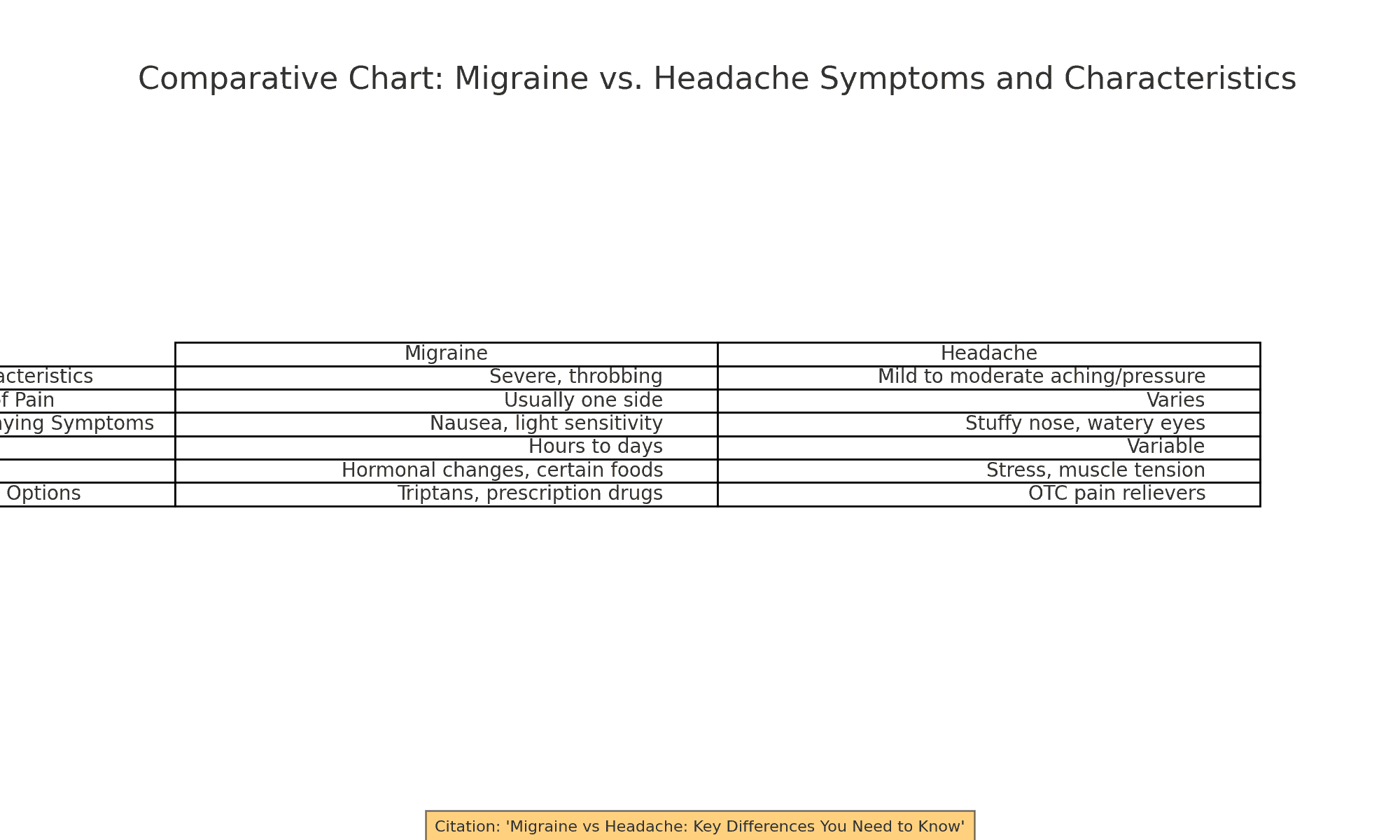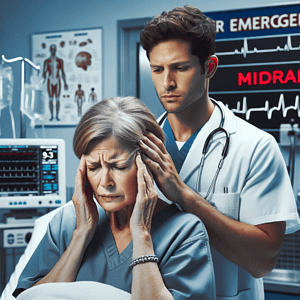Headaches and migraines are two of the most common medical complaints, yet many fail to recognize that they are distinct conditions requiring different treatment approaches. While both involve head pain, the characteristics and accompanying symptoms can help differentiate a migraine from a typical headache.
Understanding those key differences is crucial for determining the appropriate medical care. This article will compare migraine versus headache pain, symptoms, triggers, duration, impacts and treatment options so that readers may better understand and manage these unpleasant conditions.

Introduction
A headache refers to pain anywhere in the head region, which can originate from various neurological, vascular, muscle or eye-related issues. Headaches may arise occasionally or frequently, proving disruptive to one’s day-to-day life. Migraines denote a specific type of severe, recurring headache with additional sensory disruptions.

Migraine attacks have a neurochemical basis and genetic component, usually beginning in childhood or adolescence. According to the Migraine Research Foundation, over 37 million Americans suffer from migraines. Differentiating between headache types is vital for accurate diagnosis and effective treatment approaches.

Headache Overview
Myriad factors can spark headache pain, including tension, sinus congestion, medications, sleep changes, and cluster headache conditions. Common categories include:
- Tension headaches – Associated with muscle tightness and stress, causing mild to moderate pain. Over-the-counter pain relievers provide relief.
- Sinus headaches – Resulting from sinus cavity inflammation around the cheeks, eyes or forehead, aggravated by allergies or infection. Decongestants and antihistamines are go-to treatments.
- Cluster headaches – Brief but extraordinarily severe headaches recurring in clusters, along with eye redness and nasal congestion. Prescription interventions often required.
- Exertion headaches – Brought about by physical activities like exercise, sex, coughing. Usually subside with rest and hydration.
Headache symptoms can vary substantially depending on the type. Typical symptoms include:
- Pain on both or one side of the head
- Aching, pressure or tightness in the head region
- Pain level ranging from mild to severe
- Aggravation by noise, light or movement
- Stuffy nose, watery eyes or runny nose
Causes of headaches include stress, muscle tension, dehydration, sleep changes, dental issues, vision strain, sinus congestion, medication overuse and more. Determining the precipitating factors is key for treatment.
Migraine Overview
Migraines differ from common headaches in symptoms, intensity, duration and impacts. While their exact mechanisms are still being researched, migraines likely involve neurological hyper-excitability and genetic susceptibility according to the Migraine Research Foundation.
Many migraine sufferers can identify triggers like stress, hormonal fluctuations, fasting, weather changes, certain foods and more. Migraine attacks often endure hours to days, cycling through distinct phases. Symptoms include:
- Throbbing head pain, usually on one side
- Nausea and vomiting
- Light, noise and odor sensitivity
- Cognitive dysfunction
- Visual disturbances – aura
- Sensory hypesthesia
The earliest sign is often a visual aura phase appearing minutes to an hour before head pain. This sensory disruption stems from cortical spreading depression, a brain wave phenomenon. Visual auras may involve spotty vision, flashing lights or zigzagging lines. Some experience sensory hallucinations like tingling or speech difficulty.
The headache phase brings severe unilateral pulsing head pain peaking within the first day. This debilitating pain is often accompanied by nausea, vomiting, photophobia, phonophobia and mental confusion.
Finally, the postdrome phase entails lingering exhaustion and mental cloudiness for hours afterwards as the body recovers. Understanding this migraine timeline aids treatment approaches.
Key Differences Between Migraines and Headaches
While migraines fall under the generalized umbrella of headache disorders, several defining features differentiate them from tension, cluster and other headaches:
- Pain Characteristics – Migraine pain is overwhelmingly described as severe, throbbing and pounding while tension headache pain is usually mild to moderately severe with constant aching and pressure.
- Unilateral Pain – Migraines most always occur on one side of head rather than both as with other headache types.
- Other Symptoms – Additional symptoms like auras, nausea, vomiting, sound/light sensitivity and cognitive issues point to migraines as the culprit head pain.
- Duration – Migraine attacks build then fade over hours to days without treatment whereas tension headaches may persist indefinitely or resolve within several hours.
Functional Impacts -Migraines can completely incapacitate sufferers for the full attack duration while tension headaches allow continuing basic activities.
- Triggers – Migraine episodes can often be linked to triggers like sleep changes, hormonal changes, weather shifts or particular foods/drinks. Tension headaches mostly stem from emotional stress and muscle tension.
Overall, while bad headaches may stop you in your tracks temporarily, migraines frequently upend sufferers’ work, school, social and family functioning for vulnerable periods lasting days. The pain severity, cumulative impacts and disability differentiate migraines substantially from more minor headache forms.
Diagnosis and Treatment
With better understanding of the characteristic features differentiating various headache types, proper diagnosis guides appropriate, personalized management. Keeping a symptom journal detailing pain characteristics, additional symptoms, potential triggers and timing can prove invaluable for identifying patterns.
For recurrent disabling head pain episodes, establishing care with headache specialists or neurologists allows correct condition identification. This facilitates tailored treatment plans encompassing medications suited to one’s symptoms and needs plus identification of modifiable lifestyle factors.
Myriad over-the-counter and prescription options exists for both headaches and migraine. Typical tension headaches resolve well with OTC pain relievers like acetaminophen, ibuprofen and naproxen. For migraine attacks, prescription triptan drugs often successfully interrupt symptoms when taken at first signs. Long term migraine prevention relies on daily medications, nutraceuticals and lifestyle adjustments to reduce attack frequency, severity and disability.
Conclusion
Headaches come in many shapes and sizes with migraines representing an especially severe, long-lasting and disabling form. Differentiating between the common headache complaints based on pain qualities, accompanying symptoms, duration, impacts and triggers permits appropriate diagnosis and management.
While basic headaches may relent quickly to simple pain pills, debilitating migraines often warrant specialist intervention for preventive and abortive prescription therapies. Keeping a symptom diary and working with a knowledgeable provider ensures the best chance of relief. After clearly understanding the major differences outlined here between migraines versus various headaches, readers can better advocate for their own care.



